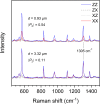Raman Analysis of Orientation and Crystallinity in High Tg, Low Crystallinity Electrospun Fibers
- PMID: 37774683
- PMCID: PMC10604433
- DOI: 10.1177/00037028231202791
Raman Analysis of Orientation and Crystallinity in High Tg, Low Crystallinity Electrospun Fibers
Abstract
Electrospun fibers of amorphous or low-crystallinity polymers typically exhibit a low molecular orientation that can hamper their properties and application. A key stage of the electrospinning process that could be harnessed to mitigate the loss of orientation is jet rigidification, which relates closely to the solvent evaporation rate. Here, we establish quantitative Raman methods to assess the molecular orientation and crystallinity of weakly crystalline poly(2,6-dimethyl-1,4-phenylene oxide) fibers with varying diameters. Our findings demonstrate that solvent volatility can be leveraged to modulate the orientation and crystallinity through its impact on the effective glass transition temperature (Tg,eff) of the polymer jet during the electrospinning process. Specifically, a highly volatile solvent yields a higher and more sustained orientation (median ⟨P2⟩ of 0.53 for diameters < 1.0 µm) because its fast evaporation rapidly increases Tg,eff above room temperature. This vitrification early along the jet path promotes the formation of an oriented amorphous phase and a moderate fraction of strain-induced crystals. Our data reveals that a high Tg is a crucial parameter for reaching high orientation in amorphous or low-crystallinity polymer systems.
Keywords: Anisotropic; Raman spectroscopy; applications; materials; polymers; quantitative analysis.
Conflict of interest statement
Declaration of Conflicting InterestsThe authors declared no potential conflicts of interest with respect to the research, authorship, and/or publication of this article.
Figures






References
-
- Tan E.P.S., Lim C.T.. “Physical Properties of a Single Polymeric Nanofiber”. Appl. Phys. Lett. 2004. 84(9): 1603–1605.
-
- Ji Y., Li B., Ge S., Sokolov J.C., Rafailovich M.H.. “Structure and Nanomechanical Characterization of Electrospun PS/Clay Nanocomposite Fibers”. Langmuir. 2006. 22(3): 1321–1328. - PubMed
-
- Pai C.-L., Boyce M.C., Rutledge G.C.. “On the Importance of Fiber Curvature to the Elastic Moduli of Electrospun Nonwoven Fiber Meshes”. Polymer. 2011. 52(26): 6126–6133.
-
- Pai C.-L., Boyce M.C., Rutledge G.C.. “Mechanical Properties of Individual Electrospun PA 6(3)T Fibers and Their Variation with Fiber Diameter”. Polymer. 2011. 52(10): 2295–2301.
-
- Park J.H., Rutledge G.C.. “Ultrafine High Performance Polyethylene Fibers”. J. Mater. Sci. 2018. 53(4): 3049–3063.
LinkOut - more resources
Full Text Sources
Miscellaneous

